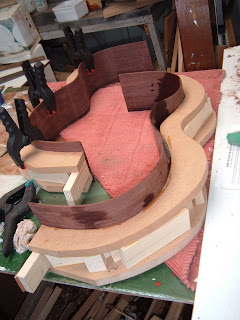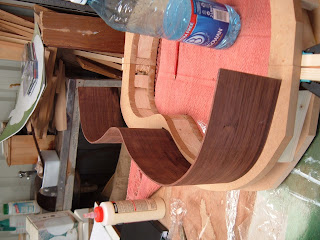In keeping with the oceanic theme on the guitar, I decided to shape the tailpiece into a whale instead of the traditional wedge shape.
I had some Walnut left over from the Dulcimer Kit that I'm making:
 - getting the width of the sides at the tailblock(3.875inches in my case) tells you how much room you have to work with. Make sure you tailpiece inlay isn't too wide either, as the sides still need to be glued to the tailblock. My tailblock is around 80-84mm wide I believe, and the inlay was around 35-40mm. I'm leaving a small bit of room above and below the Whale too, so it's more of an inlay as I said, rather than a divide between the two side pieces. It's worth noting that if you're taking measurements from a plan, to take the measurement of the side without the binding, as the diagram might show both, and your design will end up being too long for the side.
- getting the width of the sides at the tailblock(3.875inches in my case) tells you how much room you have to work with. Make sure you tailpiece inlay isn't too wide either, as the sides still need to be glued to the tailblock. My tailblock is around 80-84mm wide I believe, and the inlay was around 35-40mm. I'm leaving a small bit of room above and below the Whale too, so it's more of an inlay as I said, rather than a divide between the two side pieces. It's worth noting that if you're taking measurements from a plan, to take the measurement of the side without the binding, as the diagram might show both, and your design will end up being too long for the side.

This isn't really a big concern, as that side seemed to be a small bit longer anyway, and the plane can level it out no problems. It's the other side there, with the darker grain that the top will be stuck to, and that's the important side to have perfect.

 - I had to glue two pieces of Mahogany together to shape the neckblock out of, I scribed the measurements onto the block, and proceeded to plane off the excess.
- I had to glue two pieces of Mahogany together to shape the neckblock out of, I scribed the measurements onto the block, and proceeded to plane off the excess.



 - it was a day of doing small bits as well as big bits. I had to fill in the hairline gaps around parts of the rosette. So I used the ol' Dust and glue trick.
- it was a day of doing small bits as well as big bits. I had to fill in the hairline gaps around parts of the rosette. So I used the ol' Dust and glue trick.

- using my finger, I pressed it down all around. I couldn't see any gaps most of the way around. But while I was there with the glue, I said I may as well go around the whole thing to be safe. Last thing you want is to have it all done and sanded, and see a little gap.




 - there's a small digit cut out of Tony's template to align the centre mark, a simple, yet ingenious trick-of-the-trade.
- there's a small digit cut out of Tony's template to align the centre mark, a simple, yet ingenious trick-of-the-trade. - the hand plane. You'd be lost without one. I have researched buying them here, and even on mainland Europe. Prices are high: From €180-€450! I sourced a pair on Amazon.com for $55! There's a brand of tool called Grizzly and they seem to be cheap but popular over there. Stay tuned to see if they're any good. The way I see it is it's the blade that counts, outside of that, once the plane has a flat, even surface and comfortable handle, that's the main thing for me.
- the hand plane. You'd be lost without one. I have researched buying them here, and even on mainland Europe. Prices are high: From €180-€450! I sourced a pair on Amazon.com for $55! There's a brand of tool called Grizzly and they seem to be cheap but popular over there. Stay tuned to see if they're any good. The way I see it is it's the blade that counts, outside of that, once the plane has a flat, even surface and comfortable handle, that's the main thing for me.  - after the brace was planed on that surface that will be joined to the back, we ran it over and back on the belt sander in a gentle rocking motion. Constantly check your progress with that line you left on the brace, get it so that the line is thinning along the brace. Note, the belt sander is not on!!! If you don't have a belt sander, a strip of sandpaper taped to a flat surface will do, around the 120grit or higher.
- after the brace was planed on that surface that will be joined to the back, we ran it over and back on the belt sander in a gentle rocking motion. Constantly check your progress with that line you left on the brace, get it so that the line is thinning along the brace. Note, the belt sander is not on!!! If you don't have a belt sander, a strip of sandpaper taped to a flat surface will do, around the 120grit or higher.


P.S. I'm going on holidays for a couple of weeks. Chat y'all when I'm back!



 - keeping about 3mm outside of the line, I stuck it under the
- keeping about 3mm outside of the line, I stuck it under the 
 - clamping the side in the vice, I took off the large overhang at the shoulders. You can see the crack still there, but very
- clamping the side in the vice, I took off the large overhang at the shoulders. You can see the crack still there, but very 








 - One tail block made. As you can see in this picture, my mould wasn't aligned right. I had to make a wee wedge to slot in there.
- One tail block made. As you can see in this picture, my mould wasn't aligned right. I had to make a wee wedge to slot in there.














 - I ran the bridge under the
- I ran the bridge under the 